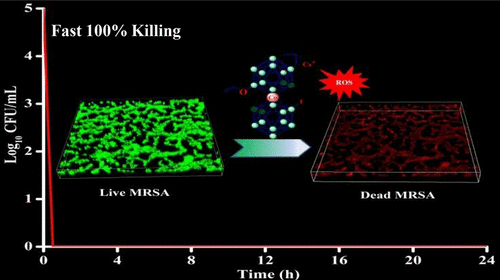当前位置:
X-MOL 学术
›
Organometallics
›
论文详情
Our official English website, www.x-mol.net, welcomes your
feedback! (Note: you will need to create a separate account there.)
A Highly Potent Antibacterial Agent Targeting Methicillin-Resistant Staphylococcus aureus Based on Cobalt Bis(1,2-Dicarbollide) Alkoxy Derivative
Organometallics ( IF 2.5 ) Pub Date : 2017-09-01 00:00:00 , DOI: 10.1021/acs.organomet.7b00426 Youkun Zheng 1 , Weiwei Liu 1 , Yun Chen 1 , Hui Jiang 1 , Hong Yan 2 , Irina Kosenko 3 , Lubov Chekulaeva 3 , Igor Sivaev 3 , Vladimir Bregadze 3 , Xuemei Wang 1
Organometallics ( IF 2.5 ) Pub Date : 2017-09-01 00:00:00 , DOI: 10.1021/acs.organomet.7b00426 Youkun Zheng 1 , Weiwei Liu 1 , Yun Chen 1 , Hui Jiang 1 , Hong Yan 2 , Irina Kosenko 3 , Lubov Chekulaeva 3 , Igor Sivaev 3 , Vladimir Bregadze 3 , Xuemei Wang 1
Affiliation

|
Methicillin-resistant Staphylococcus aureus (MRSA) is a notorious superbug that is potentially life-threatening. Among conventional antibiotics, vancomycin is a “gold standard” agent used to treat serious MRSA infections. Such therapy, however, is often ineffective because of the emergence of less-susceptible strains. Therefore, the exploration of new antimicrobial agents, especially nonantibiotic drugs, to cope with the growing threat of MRSA has become an urgent necessity. Herein, we have investigated the possibility to develop a metallacarborane antimicrobial agent, cobalt bis(1,2-dicarbollide) alkoxy derivative (K121), and we have evaluated the relevant anti-MRSA behaviors. We demonstrated that K121 has a dose-dependent anti-MRSA activity with a low minimal inhibitory concentration of 8 μg/mL and a high selectivity over mammalian cells. In particular, a high bacteria-killing efficiency was observed with eradication of all MRSA cells within 30 min. In addition, K121 showed a high inhibition effect on the formation of bacterial biofilm. More importantly, unlike vancomycin, a repeated use of K121 would not induce drug resistance even after 20 passages of MRSA. The mechanistic study showed that K121 kills MRSA by inducing an increase in the reactive oxygen species (ROS) production and consequentially inducing irreversible damage to the cell wall/membrane, which ultimately leads to the death of MRSA. Our results suggested that K121 may be used as a promising nonantibiotic therapeutic agent against MRSA infections in future clinical practices.
中文翻译:

基于双(1,2-双糖脂)钴氧基钴的耐甲氧西林金黄色葡萄球菌的高效抗菌剂
耐甲氧西林金黄色葡萄球菌(MRSA)是一个臭名昭著的超级细菌,它可能危及生命。在常规抗生素中,万古霉素是用于治疗严重MRSA感染的“金标准”药物。然而,由于不太敏感的菌株的出现,这种治疗通常是无效的。因此,探索新的抗微生物剂,特别是非抗生素药物,以应对日益增长的MRSA威胁已成为当务之急。在本文中,我们研究了开发金属碳硼烷抗微生物剂钴双(1,2-二咔唑钴)烷氧基衍生物(K121)的可能性,并评估了相关的抗MRSA行为。我们证明了K121具有剂量依赖性的抗MRSA活性,具有最低的8μg/ mL最低抑制浓度和对哺乳动物细胞的高选择性。尤其是,在30分钟内根除所有MRSA细胞,观察到很高的细菌杀灭效率。另外,K121显示出对细菌生物膜形成的高抑制作用。更重要的是,与万古霉素不同,即使多次使用MRSA,重复使用K121也不会引起耐药性。机理研究表明,K121通过诱导活性氧(ROS)产生增加而杀伤MRSA,从而对细胞壁/膜造成不可逆的破坏,最终导致MRSA死亡。我们的结果表明,在未来的临床实践中,K121可能被用作针对MRSA感染的有前途的非抗生素治疗剂。更重要的是,与万古霉素不同,即使多次使用MRSA,重复使用K121也不会引起耐药性。机理研究表明,K121通过诱导活性氧(ROS)产生增加而杀伤MRSA,从而对细胞壁/膜造成不可逆的破坏,最终导致MRSA死亡。我们的结果表明,在未来的临床实践中,K121可能被用作针对MRSA感染的有前途的非抗生素治疗剂。更重要的是,与万古霉素不同,即使多次使用MRSA,重复使用K121也不会引起耐药性。机理研究表明,K121通过诱导活性氧(ROS)产生增加而杀伤MRSA,从而对细胞壁/膜造成不可逆的破坏,最终导致MRSA死亡。我们的结果表明,在未来的临床实践中,K121可能被用作针对MRSA感染的有前途的非抗生素治疗剂。最终导致MRSA死亡。我们的结果表明,在未来的临床实践中,K121可能被用作针对MRSA感染的有前途的非抗生素治疗剂。最终导致MRSA死亡。我们的结果表明,在未来的临床实践中,K121可能被用作针对MRSA感染的有前途的非抗生素治疗剂。
更新日期:2017-09-04
中文翻译:

基于双(1,2-双糖脂)钴氧基钴的耐甲氧西林金黄色葡萄球菌的高效抗菌剂
耐甲氧西林金黄色葡萄球菌(MRSA)是一个臭名昭著的超级细菌,它可能危及生命。在常规抗生素中,万古霉素是用于治疗严重MRSA感染的“金标准”药物。然而,由于不太敏感的菌株的出现,这种治疗通常是无效的。因此,探索新的抗微生物剂,特别是非抗生素药物,以应对日益增长的MRSA威胁已成为当务之急。在本文中,我们研究了开发金属碳硼烷抗微生物剂钴双(1,2-二咔唑钴)烷氧基衍生物(K121)的可能性,并评估了相关的抗MRSA行为。我们证明了K121具有剂量依赖性的抗MRSA活性,具有最低的8μg/ mL最低抑制浓度和对哺乳动物细胞的高选择性。尤其是,在30分钟内根除所有MRSA细胞,观察到很高的细菌杀灭效率。另外,K121显示出对细菌生物膜形成的高抑制作用。更重要的是,与万古霉素不同,即使多次使用MRSA,重复使用K121也不会引起耐药性。机理研究表明,K121通过诱导活性氧(ROS)产生增加而杀伤MRSA,从而对细胞壁/膜造成不可逆的破坏,最终导致MRSA死亡。我们的结果表明,在未来的临床实践中,K121可能被用作针对MRSA感染的有前途的非抗生素治疗剂。更重要的是,与万古霉素不同,即使多次使用MRSA,重复使用K121也不会引起耐药性。机理研究表明,K121通过诱导活性氧(ROS)产生增加而杀伤MRSA,从而对细胞壁/膜造成不可逆的破坏,最终导致MRSA死亡。我们的结果表明,在未来的临床实践中,K121可能被用作针对MRSA感染的有前途的非抗生素治疗剂。更重要的是,与万古霉素不同,即使多次使用MRSA,重复使用K121也不会引起耐药性。机理研究表明,K121通过诱导活性氧(ROS)产生增加而杀伤MRSA,从而对细胞壁/膜造成不可逆的破坏,最终导致MRSA死亡。我们的结果表明,在未来的临床实践中,K121可能被用作针对MRSA感染的有前途的非抗生素治疗剂。最终导致MRSA死亡。我们的结果表明,在未来的临床实践中,K121可能被用作针对MRSA感染的有前途的非抗生素治疗剂。最终导致MRSA死亡。我们的结果表明,在未来的临床实践中,K121可能被用作针对MRSA感染的有前途的非抗生素治疗剂。









































 京公网安备 11010802027423号
京公网安备 11010802027423号